空间集聚与集聚经济
- 格式:pdf
- 大小:231.33 KB
- 文档页数:13
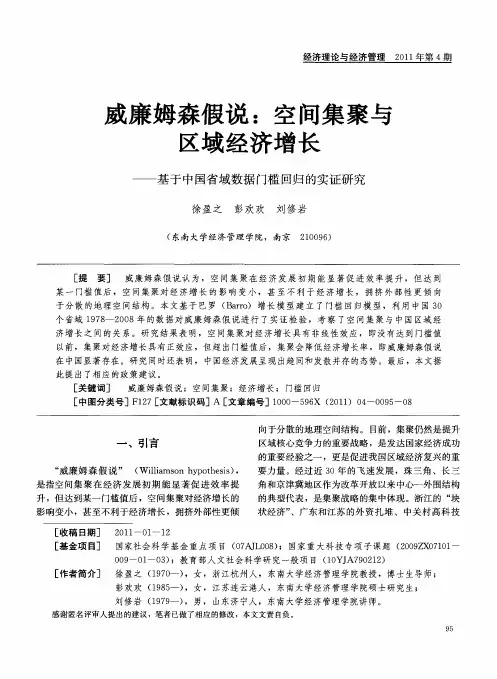
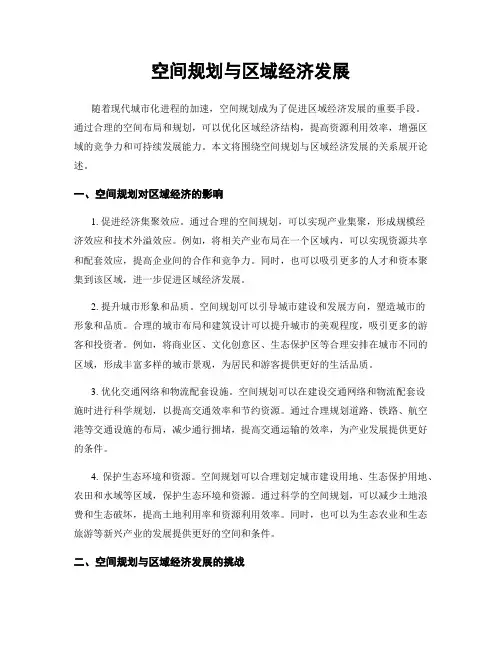
空间规划与区域经济发展随着现代城市化进程的加速,空间规划成为了促进区域经济发展的重要手段。
通过合理的空间布局和规划,可以优化区域经济结构,提高资源利用效率,增强区域的竞争力和可持续发展能力。
本文将围绕空间规划与区域经济发展的关系展开论述。
一、空间规划对区域经济的影响1. 促进经济集聚效应。
通过合理的空间规划,可以实现产业集聚,形成规模经济效应和技术外溢效应。
例如,将相关产业布局在一个区域内,可以实现资源共享和配套效应,提高企业间的合作和竞争力。
同时,也可以吸引更多的人才和资本聚集到该区域,进一步促进区域经济发展。
2. 提升城市形象和品质。
空间规划可以引导城市建设和发展方向,塑造城市的形象和品质。
合理的城市布局和建筑设计可以提升城市的美观程度,吸引更多的游客和投资者。
例如,将商业区、文化创意区、生态保护区等合理安排在城市不同的区域,形成丰富多样的城市景观,为居民和游客提供更好的生活品质。
3. 优化交通网络和物流配套设施。
空间规划可以在建设交通网络和物流配套设施时进行科学规划,以提高交通效率和节约资源。
通过合理规划道路、铁路、航空港等交通设施的布局,减少通行拥堵,提高交通运输的效率,为产业发展提供更好的条件。
4. 保护生态环境和资源。
空间规划可以合理划定城市建设用地、生态保护用地、农田和水域等区域,保护生态环境和资源。
通过科学的空间规划,可以减少土地浪费和生态破坏,提高土地利用率和资源利用效率。
同时,也可以为生态农业和生态旅游等新兴产业的发展提供更好的空间和条件。
二、空间规划与区域经济发展的挑战1. 多利益主体的协调。
空间规划涉及到不同利益主体的利益分配和协调,如政府、企业、农民等。
在实施空间规划过程中,需要平衡各方利益,协商解决可能出现的矛盾和冲突。
需要建立权益平衡机制,确保各利益主体的合法权益得到保障。
2. 规划与执行的衔接问题。
空间规划的制定与执行之间存在衔接问题,规划方案可能并不一定能够实施或者难以顺利实施。
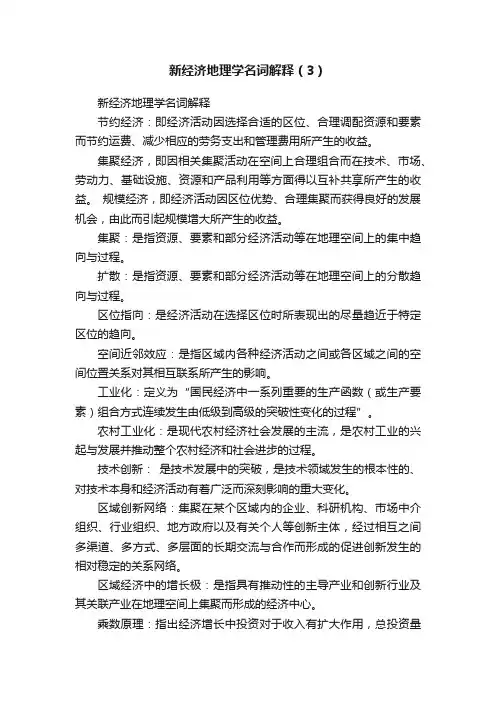
新经济地理学名词解释(3)新经济地理学名词解释节约经济:即经济活动因选择合适的区位、合理调配资源和要素而节约运费、减少相应的劳务支出和管理费用所产生的收益。
集聚经济,即因相关集聚活动在空间上合理组合而在技术、市场、劳动力、基础设施、资源和产品利用等方面得以互补共享所产生的收益。
规模经济,即经济活动因区位优势、合理集聚而获得良好的发展机会,由此而引起规模增大所产生的收益。
集聚:是指资源、要素和部分经济活动等在地理空间上的集中趋向与过程。
扩散:是指资源、要素和部分经济活动等在地理空间上的分散趋向与过程。
区位指向:是经济活动在选择区位时所表现出的尽量趋近于特定区位的趋向。
空间近邻效应:是指区域内各种经济活动之间或各区域之间的空间位置关系对其相互联系所产生的影响。
工业化:定义为“国民经济中一系列重要的生产函数(或生产要素)组合方式连续发生由低级到高级的突破性变化的过程”。
农村工业化:是现代农村经济社会发展的主流,是农村工业的兴起与发展并推动整个农村经济和社会进步的过程。
技术创新:是技术发展中的突破,是技术领域发生的根本性的、对技术本身和经济活动有着广泛而深刻影响的重大变化。
区域创新网络:集聚在某个区域内的企业、科研机构、市场中介组织、行业组织、地方政府以及有关个人等创新主体,经过相互之间多渠道、多方式、多层面的长期交流与合作而形成的促进创新发生的相对稳定的关系网络。
区域经济中的增长极:是指具有推动性的主导产业和创新行业及其关联产业在地理空间上集聚而形成的经济中心。
乘数原理:指出经济增长中投资对于收入有扩大作用,总投资量的增加可以带来若干倍于投资增量的总收入的增加。
加速原理:说明了经济增长中收入或消费量的变化如何引起投资量的变动,即在工业生产能力趋于完全利用时,消费品需求的微小增加就会导致投资的大幅增长。
经济地域综合体:是社会化大生产的地域组织形式,是以专业化部门为主体,由相关的辅助性部门和为地区服务的自给性部门结合而成的。
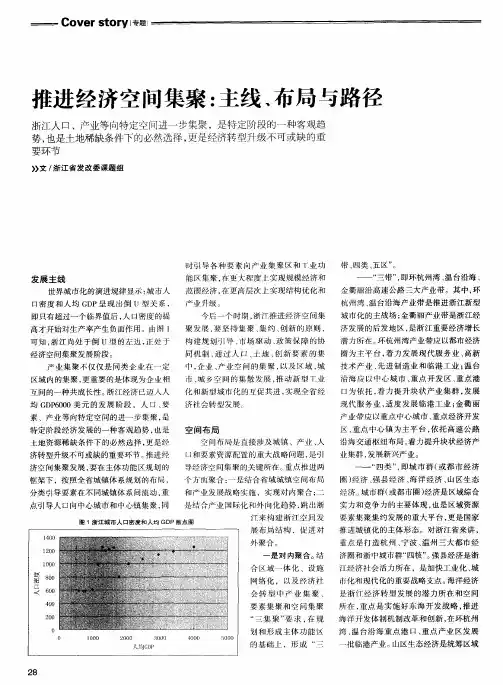
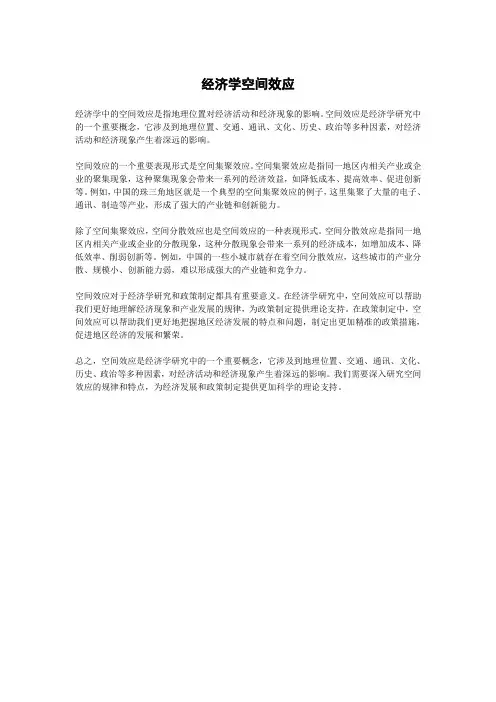
经济学空间效应
经济学中的空间效应是指地理位置对经济活动和经济现象的影响。
空间效应是经济学研究中的一个重要概念,它涉及到地理位置、交通、通讯、文化、历史、政治等多种因素,对经济活动和经济现象产生着深远的影响。
空间效应的一个重要表现形式是空间集聚效应。
空间集聚效应是指同一地区内相关产业或企业的聚集现象,这种聚集现象会带来一系列的经济效益,如降低成本、提高效率、促进创新等。
例如,中国的珠三角地区就是一个典型的空间集聚效应的例子,这里集聚了大量的电子、通讯、制造等产业,形成了强大的产业链和创新能力。
除了空间集聚效应,空间分散效应也是空间效应的一种表现形式。
空间分散效应是指同一地区内相关产业或企业的分散现象,这种分散现象会带来一系列的经济成本,如增加成本、降低效率、削弱创新等。
例如,中国的一些小城市就存在着空间分散效应,这些城市的产业分散、规模小、创新能力弱,难以形成强大的产业链和竞争力。
空间效应对于经济学研究和政策制定都具有重要意义。
在经济学研究中,空间效应可以帮助我们更好地理解经济现象和产业发展的规律,为政策制定提供理论支持。
在政策制定中,空间效应可以帮助我们更好地把握地区经济发展的特点和问题,制定出更加精准的政策措施,促进地区经济的发展和繁荣。
总之,空间效应是经济学研究中的一个重要概念,它涉及到地理位置、交通、通讯、文化、历史、政治等多种因素,对经济活动和经济现象产生着深远的影响。
我们需要深入研究空间效应的规律和特点,为经济发展和政策制定提供更加科学的理论支持。
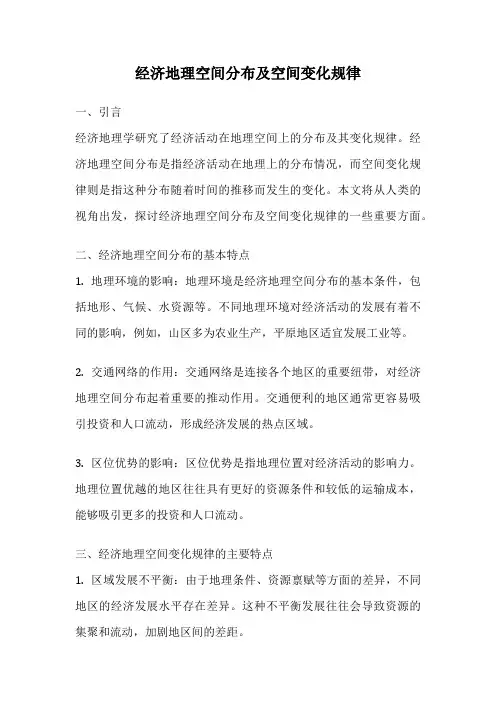
经济地理空间分布及空间变化规律一、引言经济地理学研究了经济活动在地理空间上的分布及其变化规律。
经济地理空间分布是指经济活动在地理上的分布情况,而空间变化规律则是指这种分布随着时间的推移而发生的变化。
本文将从人类的视角出发,探讨经济地理空间分布及空间变化规律的一些重要方面。
二、经济地理空间分布的基本特点1. 地理环境的影响:地理环境是经济地理空间分布的基本条件,包括地形、气候、水资源等。
不同地理环境对经济活动的发展有着不同的影响,例如,山区多为农业生产,平原地区适宜发展工业等。
2. 交通网络的作用:交通网络是连接各个地区的重要纽带,对经济地理空间分布起着重要的推动作用。
交通便利的地区通常更容易吸引投资和人口流动,形成经济发展的热点区域。
3. 区位优势的影响:区位优势是指地理位置对经济活动的影响力。
地理位置优越的地区往往具有更好的资源条件和较低的运输成本,能够吸引更多的投资和人口流动。
三、经济地理空间变化规律的主要特点1. 区域发展不平衡:由于地理条件、资源禀赋等方面的差异,不同地区的经济发展水平存在差异。
这种不平衡发展往往会导致资源的集聚和流动,加剧地区间的差距。
2. 中心-边缘模式:经济活动在空间上呈现出中心-边缘的分布模式。
中心地区通常具有较高的经济发展水平和较多的产业集聚,而边缘地区则相对较弱。
3. 空间集聚效应:经济活动在空间上具有集聚的趋势。
同类产业往往会集中在某些地区,形成产业集群,这种集聚效应能够带动经济的快速发展。
四、经济地理空间分布及空间变化规律的影响因素1. 自然因素:地形、气候、水资源等自然因素对经济地理空间分布及其变化规律起着决定性作用。
不同的自然条件会对经济活动的选择和发展产生重要影响。
2. 政策因素:政府的政策也是影响经济地理空间分布及其变化规律的重要因素。
政府的政策导向、税收优惠等都能够影响企业和人口的流动。
3. 技术进步:技术进步是推动经济地理空间分布及其变化规律发生变化的重要动力。
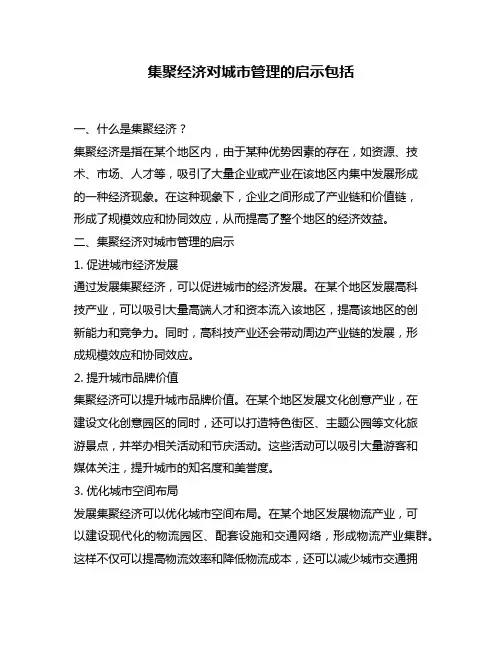
集聚经济对城市管理的启示包括一、什么是集聚经济?集聚经济是指在某个地区内,由于某种优势因素的存在,如资源、技术、市场、人才等,吸引了大量企业或产业在该地区内集中发展形成的一种经济现象。
在这种现象下,企业之间形成了产业链和价值链,形成了规模效应和协同效应,从而提高了整个地区的经济效益。
二、集聚经济对城市管理的启示1. 促进城市经济发展通过发展集聚经济,可以促进城市的经济发展。
在某个地区发展高科技产业,可以吸引大量高端人才和资本流入该地区,提高该地区的创新能力和竞争力。
同时,高科技产业还会带动周边产业链的发展,形成规模效应和协同效应。
2. 提升城市品牌价值集聚经济可以提升城市品牌价值。
在某个地区发展文化创意产业,在建设文化创意园区的同时,还可以打造特色街区、主题公园等文化旅游景点,并举办相关活动和节庆活动。
这些活动可以吸引大量游客和媒体关注,提升城市的知名度和美誉度。
3. 优化城市空间布局发展集聚经济可以优化城市空间布局。
在某个地区发展物流产业,可以建设现代化的物流园区、配套设施和交通网络,形成物流产业集群。
这样不仅可以提高物流效率和降低物流成本,还可以减少城市交通拥堵,优化城市空间布局。
4. 加强城市创新能力通过发展集聚经济,可以加强城市的创新能力。
在某个地区发展生物医药产业,可以建设生命科学园区、研究机构等配套设施,并吸引大量高端人才和资本投入该领域。
这样不仅可以提高该地区的创新能力和技术水平,还可以推动相关领域的技术进步和产业升级。
5. 促进城乡一体化发展通过发展集聚经济,可以促进城乡一体化发展。
在某个地区发展农业产业园区,可以将农村资源、土地、劳动力等优势因素与现代农业技术相结合,提高农业生产效率和质量。
同时,还可以带动周边农村经济的发展,促进城乡一体化发展。
三、如何发展集聚经济?1. 找准优势产业要发展集聚经济,首先需要找准优势产业。
可以通过市场调研、政策引导等方式,确定该地区的产业特色和优势方向。
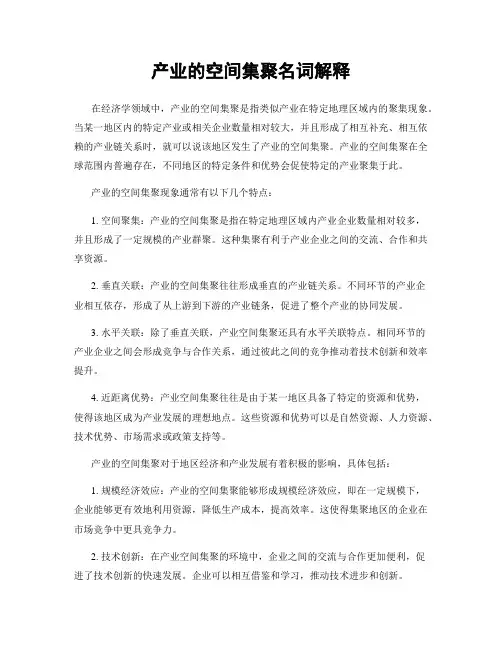
产业的空间集聚名词解释在经济学领域中,产业的空间集聚是指类似产业在特定地理区域内的聚集现象。
当某一地区内的特定产业或相关企业数量相对较大,并且形成了相互补充、相互依赖的产业链关系时,就可以说该地区发生了产业的空间集聚。
产业的空间集聚在全球范围内普遍存在,不同地区的特定条件和优势会促使特定的产业聚集于此。
产业的空间集聚现象通常有以下几个特点:1. 空间聚集:产业的空间集聚是指在特定地理区域内产业企业数量相对较多,并且形成了一定规模的产业群聚。
这种集聚有利于产业企业之间的交流、合作和共享资源。
2. 垂直关联:产业的空间集聚往往形成垂直的产业链关系。
不同环节的产业企业相互依存,形成了从上游到下游的产业链条,促进了整个产业的协同发展。
3. 水平关联:除了垂直关联,产业空间集聚还具有水平关联特点。
相同环节的产业企业之间会形成竞争与合作关系,通过彼此之间的竞争推动着技术创新和效率提升。
4. 近距离优势:产业空间集聚往往是由于某一地区具备了特定的资源和优势,使得该地区成为产业发展的理想地点。
这些资源和优势可以是自然资源、人力资源、技术优势、市场需求或政策支持等。
产业的空间集聚对于地区经济和产业发展有着积极的影响,具体包括:1. 规模经济效应:产业的空间集聚能够形成规模经济效应,即在一定规模下,企业能够更有效地利用资源,降低生产成本,提高效率。
这使得集聚地区的企业在市场竞争中更具竞争力。
2. 技术创新:在产业空间集聚的环境中,企业之间的交流与合作更加便利,促进了技术创新的快速发展。
企业可以相互借鉴和学习,推动技术进步和创新。
3. 人力资源集聚:产业空间集聚吸引了大量的人才聚集于此,形成了人才密集的地区。
这对于企业的人才引进和培养提供了便利,促使产业的持续发展。
4. 社会经济效益:产业的空间集聚还能为当地经济社会发展带来许多积极效益。
例如,增加就业机会、增加税收收入、改善基础设施建设等,进而提高地区居民的生活水平。
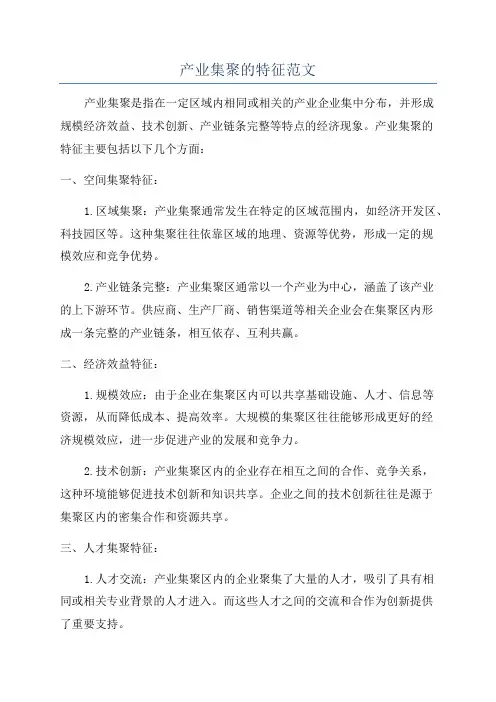
产业集聚的特征范文产业集聚是指在一定区域内相同或相关的产业企业集中分布,并形成规模经济效益、技术创新、产业链条完整等特点的经济现象。
产业集聚的特征主要包括以下几个方面:一、空间集聚特征:1.区域集聚:产业集聚通常发生在特定的区域范围内,如经济开发区、科技园区等。
这种集聚往往依靠区域的地理、资源等优势,形成一定的规模效应和竞争优势。
2.产业链条完整:产业集聚区通常以一个产业为中心,涵盖了该产业的上下游环节。
供应商、生产厂商、销售渠道等相关企业会在集聚区内形成一条完整的产业链条,相互依存、互利共赢。
二、经济效益特征:1.规模效应:由于企业在集聚区内可以共享基础设施、人才、信息等资源,从而降低成本、提高效率。
大规模的集聚区往往能够形成更好的经济规模效应,进一步促进产业的发展和竞争力。
2.技术创新:产业集聚区内的企业存在相互之间的合作、竞争关系,这种环境能够促进技术创新和知识共享。
企业之间的技术创新往往是源于集聚区内的密集合作和资源共享。
三、人才集聚特征:1.人才交流:产业集聚区内的企业聚集了大量的人才,吸引了具有相同或相关专业背景的人才进入。
而这些人才之间的交流和合作为创新提供了重要支持。
2.人才培养:由于产业集聚区内的企业需要大量的人才支持,因此相关的职业教育和培训机构也会相对集中。
这些机构会培养出更多符合产业需求的人才,进一步促进了产业的发展。
四、市场优势特征:1.国内市场:产业集聚区往往会形成一个庞大的市场规模,这使得区内企业在国内市场上拥有更大的竞争力。
集聚区内的企业可以通过合作、协同效应等手段与其他企业形成联盟,共同开拓市场。
2.国际市场:由于产业集聚区内企业规模较大,拥有相对先进的技术和管理水平,因此往往能够更容易地进入国际市场。
集聚区内的企业可以共同承担风险、分享机会,提高国际竞争力。
总之,产业集聚具有空间集聚、经济效益、人才集聚和市场优势等特征。
这种特征使得产业集聚能够促进区域经济的发展和创新能力的提升,成为推动经济增长的重要力量。

NBER WORKING PAPER SERIESTHE WEALTH OF CITIES:AGGLOMERATION ECONOMIES AND SPATIAL EQUILIBRIUM IN THE UNITED STATESEdward L. GlaeserJoshua D. GottliebWorking Paper 14806/papers/w14806NATIONAL BUREAU OF ECONOMIC RESEARCH1050 Massachusetts AvenueCambridge, MA 02138March 2009Thanks to Roger Gordon and three anonymous referees for valuable comments. Glaeser thanks the Taubman Center for State and Local Government and Gottlieb thanks the Institute for Humane Studies for support. The views expressed herein are those of the author(s) and do not necessarily reflect the views of the National Bureau of Economic Research.© 2009 by Edward L. Glaeser and Joshua D. Gottlieb. All rights reserved. Short sections of text, not to exceed two paragraphs, may be quoted without explicit permission provided that full credit, including © notice, is given to the source.The Wealth of Cities: Agglomeration Economies and Spatial Equilibrium in the United States Edward L. Glaeser and Joshua D. GottliebNBER Working Paper No. 14806March 2009JEL No. D0,D00,R0,R00ABSTRACTEmpirical research on cities starts with a spatial equilibrium condition: workers and firms are assumed to be indifferent across space. This condition implies that research on cities is different from research on countries, and that work on places within countries needs to consider population, income and housing prices simultaneously. Housing supply elasticity will determine whether urban success shows up in more people or higher incomes. Urban economists generally accept the existence of agglomeration economies, which exist when productivity rises with density, but estimating the magnitude of those economies is difficult. Some manufacturing firms cluster to reduce the costs of moving goods, but this force no longer appears to be important in driving urban success. Instead, modern cities are far more dependent on the role that density can play in speeding the flow of ideas. Finally, urban economics has some insights to offer related topics such as growth theory, national income accounts, public economics and housing prices.Edward L. GlaeserDepartment of Economics315A Littauer CenterHarvard UniversityCambridge, MA 02138and NBEReglaeser@Joshua D. GottliebDepartment of EconomicsLittauer Center 200Harvard UniversityCambridge, MA 02138/~jdgottl/jdgottl@I. IntroductionMuch economic research has focused on “the wealth of nations.” Many economists have tried to understand national business cycles and the higher incomes and faster income growth that occur in some countries. Yet the within-country differences in income and productivity are also quite striking. The average income per capita in 2007 in the San Francisco metropolitan area was above almost 60,000 dollars; the comparable figure for Brownsville, Texas, is under 20,000 dollars. Per capita gross metropolitan product (GMP) is more than three times higher in New York than in El Paso.2 The differences in population density across space within countries are even more striking. As of the last census, 68 percent of Americans occupied only 1.8 percent of the country’s land area.Facts of this sort motivate the central question of urban economics: Why do cities exist? To answer this question we also must also understand why dense areas are so much more productive. Urban economists approach this question by studying, among other things, within-country variation in incomes, population density and housing prices. This allows them to treat population densities appropriately—as outcomes that are determined jointly with prices and wages. The field’s central theoretical tool is the spatial equilibrium, which assumes that welfare is equalized across space—at least for marginal migrants. The spatial equilibrium concept guides urban models of housing prices and industrial agglomeration as well as empirical work on city growth and the urban wage premium.In this paper, we review recent research on the economics of cities. We begin by presenting a version of the standard spatial equilibrium model that guides our interpretation of empirical work. The model has three core equilibrium conditions. Workers must be indifferent between locations, firms must be indifferent about hiring more workers and builders must be indifferent about supplying more housing. These three conditions provide the labor supply curve, housing supply curve and labor demand curve that collectively determine area population, wages and prices. Exogenous differences across space in productivity, amenities and the construction sector2 Gross Metropolitan Product is produced by the Bureau of Economic Analysis, and is meant to be comparable to Gross Domestic Product.drive differences in density, incomes and home prices. We allow for the possibility of agglomeration economies, which exist when productivity rises with population.We first use this model to discuss the dramatic rise of Sunbelt cities. No variable can better predict city growth over the past 50 years than January temperature, yet it is unclear a priori why warm places have grown so dramatically. The spatial equilibrium model enables us to assess whether this growth reflects rising Sunbelt productivity, or an increased willingness to pay to enjoy warmth, or greater housing supply in the South. Over the past 50 years, Sunbelt productivity has increased, but in the past decade incomes have fallen in warmer areas. Housing prices have also stayed low and real wages have risen in the South. These facts, interpreted using the spatial equilibrium model, imply that the recent rise of cities like Atlanta, Dallas and Houston owes more to elastic housing supply than to amenities or productivity.The spatial equilibrium model is also needed to make sense of the dramatic connection between density and income within the U.S. (Ciccone and Hall, 1996). The standard regression of income on population makes little sense if population levels themselves endogenously increase with rising productivity. Natural factors or historical population levels are valid instruments for current population only if those instruments operate through shifts in housing supply or amenities that affect population for reasons unrelated to productivity. Despite the difficulties involved in estimating agglomeration economies, the dramatic concentration of people in high-income urban areas and the absence of obvious exogenous sources of productivity heterogeneity have lead most urban economists to believe that important agglomeration economies exist.In Section III of this paper, we review three core theories about agglomeration economies. Cities are ultimately nothing more than proximity, so the returns to urban concentration can be seen as reductions in transport costs. One set of theories about agglomeration economies emphasizes the gains that come from reduced costs of moving goods across space (Krugman, 1991a). A second set of theories emphasizes labor market pooling and the benefits of moving people across firms (Marshall, 1890). A third set argues that cities speed the flow of ideas, which creates human capital at the individual level and facilitates innovation (Jacobs, 1968). Some of thesetheories emphasize the benefits that come from co-location of diverse firms; others emphasize the gains from single-industry agglomerations.Empirical research on the sources of agglomeration economies uses information on both prices (the wages of workers) and quantities (the location of industry). For example, evidence on the co-location of industries shows that firms locate near industries that are suppliers or customers (Ellison, Glaeser, and Kerr, 2007; Kolko, 2000). The existence of human capital spillovers is suggested both by the positive correlation between individual wages and skills in the city, and by the connection between skills and city population growth.Despite the long history of research on these questions, the field has still not reached a consensus on the relative importance of different sources of agglomeration economies. There is some evidence supporting the continued importance of transport costs for goods. Gravity models suggest that firms are drawn to areas with robust local demand. Evidence on the co-location of industries provides further support for the importance of input-output linkages in determining industrial location, but these effects are often small. However, manufacturing firms and industries with high transport costs tend to avoid dense, urban areas. These facts cast doubt on the view that cities succeed by reducing the costs of moving goods. Labor market pooling and the gains from being able to move across firms remains an important idea, but no one has managed to make the case that cities rise or fall based on this force.A significant body of recent evidence points to the importance of skills and ideas in determining urban success. Cities with higher concentrations of skilled workers pay higher wages, and this tendency has been rising over time (Rauch, 1993). Skills predict urban growth, especially in the colder areas of the country (Glaeser, Scheinkman and Shleifer, 2005). Workers who come to cities don’t receive the urban wage premium immediately, but instead experience faster wage growth rates, which suggests faster human capital accumulation in urban areas (Glaeser and Mare, 2001).After reviewing the empirical work on the economics of urban agglomerations, we turn to the insights from urban research that might be useful for other fields. For growth and development,the evidence from cities supports the view that human capital is a particularly important source of productivity and productivity growth. Urban intellectual interactions mean that innovations are highly correlated within cities and we should expect to see significant heterogeneity in the rate of technological change across space. As a result, it may make more sense to attribute events like the English industrial revolution to the random connection of a few people than to deep-seated national characteristics.The urban perspective emphasizes factor mobility and challenges researchers looking at sub-national data to analyze income, population and housing prices simultaneously. Running naïve income change regressions, without also considering changes in employment and housing prices, misses the fact that labor is quite mobile across places within the U.S. Housing supply elasticity will determine how much an intervention affects urban prices and quantities. These insights are essential for public economists seeking to use state-by-state variation to assess different policies and for growth economists using within-country data.Urban economics also suggests that there are difficulties with using aggregate data to understand national inequality and income levels. Since higher-income people live disproportionately in high-income, high-cost areas, while lower-income people live disproportionately in low-cost areas, a failure to correct for local prices and amenities will overstate national income inequality. In particular, we have to be wary of using expenditure-weighted mean prices to correct for the income of the median household. Those price indices will tend to reflect the high housing prices in high-cost areas even though the median household is likely to live in a cheaper area and face a lower cost index.House prices represent the interaction of supply conditions and the individuals’ desires to live and work in certain locales. Factors such as income heterogeneity across space, amenities and land use restrictions will therefore drive housing prices. This approach is quite different from the macroeconomic perspective, which emphasizes national income and interest rates. The urban perspective on housing also differs from the standard finance perspective on housing, by emphasizing that individuals begin life short housing (Sinai and Souleles, 2003). Changes inhouse prices do not naturally represent an increase in national wealth since the increase in asset values has been offset by an increase in price of securing a basic necessity.Finally, the urban emphasis on mobility implies that local poverty is more likely to reflect something good that an area is providing for the poor than a failure in local labor markets. Poor people are attracted to big cities because they offer access to public transportation and inexpensive rental housing. Further attempts to improve the lives of poor people will tend to attract more poor people to places where other low-income people live.We now turn to the spatial equilibrium model that unifies urban economics.II. Metropolitan Heterogeneity and Spatial EquilibriumJust as macroeconomics explores both differences in growth rates and differences in GDP levels across countries, urban economists wonder why some cities are rich, some cities are growing, and others are doing neither. Why have some southern cities, such as Atlanta, and some former rustbelt areas like Boston seen dramatic increases in output per capita over the last 30 years, while others, like Detroit and Flint, have declined from great industrial centers to places known more for poverty than for production? How is it possible that the gap between poor and rich areas within a single country can be over 100 percent? Most importantly, why is there such a strong connection between city size and productivity, as shown in Figure 1?One response to these puzzles is that productivity differences represent temporary aberrations that will disappear as capital flees high cost areas and labor follows higher wages. Table 1 shows the correlation between initial income levels at the metropolitan area and ex post changes in both income and population for each decade since the 1960s.3 We have reported the coefficients and standard errors from regressing the change in the logarithm of income and the change in the logarithm of population against the initial income level.3 Metropolitan areas are the standard unit of analysis for much of urban economics. These areas represent multi-county groupings defined by the U.S. Census Bureau, and are more appropriate to work with than cities because they are not defined by arbitrary political boundaries.In every decade except the 1980s, there has been substantial income convergence. Convergence seems to have slowed down since 1980, but the tendency of incomes to grow faster in poorer places, emphasized by Barro and Sala-i-Martin (1991), continues to hold. (But measurement error in income can lead to a spurious finding of mean reversion, so these facts must be treated warily.) The second column shows the relationship between initial income in each decade and subsequent population growth. If people migrate to high income areas, then we would expect initially high incomes to predict population growth. There is a positive relationship between income and population growth in the 1960s, a negative correlation in the 1970s and no significant relationship since then. Incomes are converging, but this is not because people are moving to disproportionately to high wage areas.Does the phenomenon of income convergence suggest that current income differences are only temporary? Figure 2 shows the 0.77 correlation between the logarithm of income per capita in 1970 and income per capita in 2000.4 There has been some convergence since 1970, but over 30 years, rich places have stayed rich and poor places have stayed poor. This continuing income disparity has motivated urban economists to think about a spatial equilibrium where differences in per capita income and prices can persist for many decades.The Spatial EquilibriumThe methods employed by urban and growth economists differ along one major dimension. Cross-national work rarely, if ever, assumes that welfare levels are equalized across space. After all, one goal of cross-country work is to understand how to make people in poorer countries better off. However, since the pioneering work of Mills (1967), Rosen (1979) and Roback (1982), cross-city work has almost always assumed that the free migration of workers creates a spatial equilibrium where utility levels are equalized. This assumption reflects the fact that over 40 percent of Americans change homes and around 20 percent of Americans change counties every five years.4 This correlation is substantially lower if 1960 rather than 1970 is used as the initial point. The very high degrees of income convergence over the 1960 make that decade somewhat unusual over the past forty years.The high mobility of labor leads urban economists to assume a spatial equilibrium, where elevated New York incomes do not imply that New Yorkers are better off. Instead, welfare levels are equalized across space and high incomes are offset by negative urban attributes such as high prices or low amenities. By assuming that workers choose their locations, urban economists gain at least the possibility of explaining the large concentrations of people in urban area. We can only explain city sizes if our models allow people to move into cities.5Following the standard models of urban economics, we assume people can move across places immediately and costlessly. In reality, of course, these adjustments take time and money. Blanchard and Katz (1992) quantify the process of these adjustments and find that regional shocks are largely absorbed by migration flows, and house prices take around five years to adjust. Glaeser and Gyourko (2005) argue that durable housing may cause urban responses to productivity shocks to be spread over decades. Hornbeck (2008) finds that large exogenous shocks to specific regions—specifically due to soil erosion during the Dust Bowl—were mostly absorbed over long periods by largely-permanent migration. Saks and Wozniak (2007) find that migration flows respond strongly to business cycle variables, and do so differentially for workers in different stages of their careers, and Glaeser and Redlick (2008) find that education influences the size of migration flows.The slow migration response to local shocks does not imply that spatial equilibrium holds only over long periods. As long as house prices or rents can change quickly, the price adjustment suffices to maintain the spatial equilibrium. Glaeser et al. (1995) use a spatial equilibrium model where migration responds slowly to shocks but the spatial equilibrium is always maintained because of housing price flexibility. This leads us to ask if this is occurs in practice: Do housing costs actually move enough to equalize utility levels across space?If anything, Glaeser and Gyourko (2007) find that there is too much housing price volatility relative to volatility in local incomes. More generally, measurement difficulties mean that it is quite difficult to reject the hypothesis that welfare levels are equalized across space. The5 In principle, fertility differences can also explain higher density levels in some places, but fertility differences are far too small to explain heterogeneity in area population levels.difficulties of assessing expected housing price appreciation makes it difficult to measure expected housing costs for homeowners. The fact that only a modest percentage of the population rents, and rental units are quite different from the standard stock, makes it difficult to avoid this problem by using rental prices. Researchers who use the spatial equilibrium assumption can either feel comfortable knowing that this assumption has never been rejected empirically or uncomfortable because data limitations make it impossible to test rigorously at high temporal frequencies. It is hard to see how urban economists could test the spatial equilibrium assumption with the same degree of empirical precision used by financial economists to evaluate the no arbitrage assumption in financial markets.American scholars often find it more natural to assume a spatial equilibrium than their European counterparts. After all, migration flows are much larger in the U.S. than in Europe, and Decressin (1993) finds that population flows in Europe respond much less to local labor market shocks. Hopefully, future work will better enable to us to determine whether Europe regions are better understand as separate economies or as places linked by the free migration of labor. There is also a tradition of using the spatial equilibrium model in developing countries. The Harris-Todaro (1970) model, where high wages in big cities are offset by high levels of unemployment is a classic example.The presence of migrants who bring the country into spatial equilibrium requires us to interpret many city characteristics as equilibrium outcomes rather than exogenous forces. In particular, a complete urban model has at least three key area-level dependent variables: wages, population levels and housing prices. These three variables are determined by three equilibrium conditions. First, workers must be indifferent across space. This ensures that real wages, corrected for local price and amenity levels, must be equalized across metropolitan areas. Second, firms must be in equilibrium, which means that wages equal the marginal productivity of labor. Third, the housing market must be in equilibrium, which requires housing prices to equal the costs of providing housing, at least in growing markets.The individuals’ location choice implies a spatial equilibrium where identical people have the same utility level across space. Following Alonso’s (1964) pioneering book, a rich literature hasexamined the spatial equilibrium assumption within metropolitan areas. The most studied implication of that assumption was that prices would decline with commuting costs. DiPasquale and Wheaton (1996) provide the textbook treatment of this topic. Other authors have looked at the connection between housing costs and local amenities, such as good schools (e.g. Black, 1999) or disamenities, such as airports and crime (e.g. Thaler, 1978).6The primary difference between the within-city spatial equilibrium work and the research that has applies the assumption across cities, is that within cities wages are typically treated as fixed. Across cities, wages differ and higher nominal wages are typically offset by higher housing costs. Higher real wages are offset by lower amenities. The spatial equilibrium yields some counterintuitive implications; for example, high real wages in an area imply that something else is bad about the place. Rochester, Minnesota, and Springfield, Illinois, are two American metropolitan areas with extremely high real wages.While correcting for national price levels almost always makes sense, there is considerable information in local incomes that is lost by correcting for local price levels. When we assume that firms behave competitively, the marginal product of labor will be reflected in nominal local wages—not wages corrected for local prices. That information can be lost when we correct for local prices. In addition, if amenities are constant across space, then the spatial equilibrium model predicts that real wages will also be constant. Yet some places may have high wages, and high productivity levels, that are offset by high prices. Those high wages are informative because they help us to understand the correlates of local productivity. High prices will also be informative since they yield information about supply conditions in the local housing market.People and Prices Across SpaceWe now turn to a benchmark model that draws on Rosen (1979) and Roback (1982) and can serve as the basis for empirical work on cities. Like growth economists, we begin with the6 See Glaeser (2008, ch. 2) for a recent discussion of the literature on intra-city prices and allocation of people, as well as evidence supporting the rent gradient model of Alonso (1964), Muth (1969), and Mills (1967) (which itself is summarized in Brueckner [1987]). Baum-Snow (2007b) represents a significant recent addition to this body of research.production function: , , where is a time-city specific productivity variable, F(.,.) is a constant returns to scale production function, K is capital and L is labor. The Cobb-Douglas production function, , is particularly natural for empirical work. This can either be thought of as an aggregate production function or a firm-level production function in a world with an elastic supply of firms.The factor inputs, K and L, can represent scalars or vectors. Given the importance that skilled workers seem to play in urban growth, it is particularly natural to divide the labor force into two types of labor, but here we will treat labor as homogeneous. We will divide capital into traded capital, denoted , that is bought at a nationwide, exogenous price of , and non-traded capital, denoted , that is city-specific and bought at local, endogenous price of . The stock of non-traded capital is fixed at .We assume that total capital K, is a geometric weighted average of the two types of capital so that total output is , where denotes reflects the share of non-traded capital. Non-traded capital offers diminishing returns at the city level, even when firms themselves face constant returns to scale. Firms’ first order condition for labor produces a city-level labor demand equation of , where depends on constant terms, including the price of traded capital. At the city level, higher wages reflect higher productivity, more non-traded capital or fewer workers.In the economics of growth following Solow (1956), the production function is then connected to savings and investment decisions. Occasionally, the labor force itself is connected to fertility decisions (Barro and Becker, 1989). In urban models, these more dynamic considerations are generally swept under the rug. Non-traded capital is fixed and traded capital is perfectly elastically supplied at the fixed price. More sophisticated investment decisions could be brought into urban economics, and probably should be, but these issues have generally been treated as second-order.The utility levels of workers are assumed to equal , , , where is the consumption of traded goods, refers to non-traded goods (especially housing) and represents localamenities. As in Roback (1982), this can be reduced to an indirect utility function , , where is income in place i at time t and is the price of non-traded goods. In a static model, the spatial equilibrium assumption means that utility levels are equal across space. In a dynamic model, the spatial equilibrium assumption generally means only the lifetime utility levels will be equalized across space, but if migration is sufficiently cheap, it also implies that utility flows are equalized across space. Holding amenities constant, this yields the prediction that:where the ratioequals the demand for the non-traded good. High income levels areoffset by high prices.Again, the Cobb-Douglas utility function is a natural way to empirically use the spatial equilibrium assumption. Under this assumption, utility can be written as : , which will equal times a constant. The spatial equilibrium assumption requires this to equal , the reservation utility within the country. This formulation suggests that1 . Figure 3 shows the relationship between the logarithm of median home prices and the logarithm of median household income across space. The coefficient is 0.34, which is quite close to the average share of expenditure on housing, or 1 .The final critical production sector concerns the making of non-traded goods, or homes. If we are interested in a truly static model, as in Roback (1982), it is natural to follow her assumption that non-traded goods are produced like traded goods with labor, traded capital and non-traded capital. In this case, the production function might be , , where refers to productivity in this sector. We will assume that the traded capital here is the same as the traded capital in the traded goods sector, but that non-traded goods require their own, distinct form of non-traded capital (presumably land), denoted .If total production of the non-traded good equals , then total output for thisgood will equal a constant times. The total labor allocated to theproduction of non-traded goods is 1 1 times the total population of the city. These equations can then be used to solve for city size, city wages and the wages of non-traded goods:。

新经济地理学原理
新经济地理学是一门结合了经济学和地理学的学科,旨在研究经济活动的空间分布和地理位置对经济增长和发展的影响。
以下是新经济地理学的一些原理:
1. 集聚经济:集聚经济是指在特定地区集中了大量的产业和人口,从而带来了规模经济和外部性。
这种集聚经济可以提高生产效率、降低成本,并促进技术创新和知识溢出。
2. 空间自相关:空间自相关是指在空间上相邻的地区之间存在着相互影响的关系。
这种自相关可以是正相关或负相关,取决于相邻地区的经济发展水平和产业结构。
3. 区位选择:企业和家庭在选择区位时会考虑多种因素,如成本、市场、技术和政策等。
这些因素会影响企业和家庭的生产和消费行为,并对经济增长和发展产生影响。
4. 区域经济政策:政府可以通过制定区域经济政策来促进经济增长和发展。
这些政策可以包括投资补贴、税收优惠、基础设施建设等,以吸引企业和人口向特定地区聚集。
5. 全球化:全球化是指经济活动在全球范围内的整合和互动。
全球化对新经济地理学的影响主要体现在跨国公司的选址和国际贸易的发展上。
新经济地理学的原理为我们提供了一个理解经济活动空间分布的框架,并为政府制定区域经济政策提供了理论支持。
空间分布与产业集聚在现代经济发展中,空间分布和产业集聚是两个重要的概念。
空间分布指的是不同产业在地理空间上的分布情况,而产业集聚则是指相同或相关产业在某一地区集中发展的现象。
空间分布与产业集聚之间存在着紧密的联系和影响。
首先,空间分布对产业集聚有着明显的影响。
不同的地理环境和资源分布会直接影响到产业的发展。
比如,像石油、煤炭等资源密集的地区,往往会吸引相关产业的集聚,形成资源型经济。
而像沿海地区则相对更适合发展制造业和贸易等产业。
此外,交通和基础设施的发展也是产业集聚的重要因素。
交通便利的地区可以促进产业之间的联系和交流,有利于形成产业集聚效应。
其次,产业集聚对空间分布也产生着推动作用。
当某一产业在特定地区形成集聚效应后,会吸引更多的企业和资源向该地区集中。
这种不断聚集的趋势会形成产业聚集区,进一步扩大产业的规模和影响力。
这种现象在中国的珠江三角洲和长三角地区都可以很好地体现出来。
珠江三角洲以制造业和出口为主,而长三角地区以高科技和服务业为主,这些产业集聚区成为了中国经济的重要支撑。
此外,空间分布与产业集聚还与区域经济发展密切相关。
产业集聚不仅能够提高区域经济的竞争力,还可以促进该地区的经济多样化和创新能力。
在产业集聚区,企业之间的竞争和合作可以促进技术的交流和创新的产生。
同时,产业集聚还可以形成人才聚集的效应,吸引专业人才和高素质人才的流入,进一步促进地区的发展。
然而,空间分布与产业集聚也存在一些问题和挑战。
一方面,过度依赖某一产业集聚可能造成地区经济的不平衡。
当该产业遇到困难或出现衰退时,整个地区经济都会受到重大冲击。
另一方面,产业集聚也可能导致资源的不平衡分配和环境的恶化。
大量的企业和人口聚集在一地,会对当地的资源、能源和环境造成压力。
因此,合理引导和管理产业集聚,保持地区经济平衡和可持续发展,是一个重要的课题。
综上所述,空间分布与产业集聚是经济地理学中的重要概念。
它们之间相互影响、相互作用,为地区经济的发展和繁荣提供了基础。